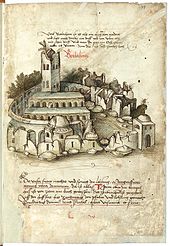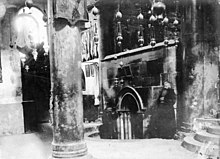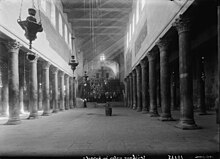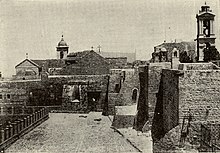Church of the Nativity
The Church of the Nativity, or Basilica of the Nativity, is a basilica located in Bethlehem in the State of Palestine, in the West Bank. The grotto holds a prominent religious significance to Christians of various denominations as the birthplace of Jesus. The grotto is the oldest site continuously used as a place of worship in Christianity, and the basilica is the oldest major church in the Holy Land.
The church was originally commissioned by Constantine the Great a short time after his mother Helena's visit to Jerusalem and Bethlehem in 325–326, on the site that was traditionally considered to be the birthplace of Jesus. That original basilica was likely built between 330 and 333, being already mentioned in 333, and was dedicated on 31 May 339. It was probably destroyed by fire during the Samaritan revolts of the sixth century, possibly in 529, and a new basilica was built a number of years later by Byzantine Emperor Justinian (r. 5...Read more
The Church of the Nativity, or Basilica of the Nativity, is a basilica located in Bethlehem in the State of Palestine, in the West Bank. The grotto holds a prominent religious significance to Christians of various denominations as the birthplace of Jesus. The grotto is the oldest site continuously used as a place of worship in Christianity, and the basilica is the oldest major church in the Holy Land.
The church was originally commissioned by Constantine the Great a short time after his mother Helena's visit to Jerusalem and Bethlehem in 325–326, on the site that was traditionally considered to be the birthplace of Jesus. That original basilica was likely built between 330 and 333, being already mentioned in 333, and was dedicated on 31 May 339. It was probably destroyed by fire during the Samaritan revolts of the sixth century, possibly in 529, and a new basilica was built a number of years later by Byzantine Emperor Justinian (r. 527–565), who added a porch or narthex, and replaced the octagonal sanctuary with a cruciform transept complete with three apses, but largely preserved the original character of the building, with an atrium and a basilica consisting of a nave with four side aisles.
The Church of the Nativity, while remaining basically unchanged since the Justinianic reconstruction, has seen numerous repairs and additions, especially from the Crusader period, such as two bell towers (now gone), wall mosaics and paintings (partially preserved). Over the centuries, the surrounding compound has been expanded, and today it covers approximately 12,000 square meters, comprising three different monasteries: one Catholic, one Armenian Apostolic, and one Greek Orthodox, of which the first two contain bell towers built during the modern era.
The silver star marking the spot where Christ was born, inscribed in Latin, was stolen in October 1847 by Greek monks who wished to remove this Catholic item. Some assert that this was a contributing factor in the Crimean War against the Russian Empire. Others assert that the war grew out of the wider European situation.
Since 2012, the Church of the Nativity is a World Heritage Site and was the first to be listed by UNESCO under 'Palestine'.
Since 1852, the rights of the three religious communities are ruled by Status Quo.
The holy site known as the Nativity Grotto is thought to be the cave in which Jesus was born. In 135, Emperor Hadrian had the site above the grotto converted into a worship place for Adonis, the mortal lover of Aphrodite, the Greek goddess of beauty and desire.[1][2] Jerome claimed in 420 that the grotto had been consecrated to the worship of Adonis, and that a sacred grove was planted there in order to completely wipe out the memory of Jesus from the world.[1][3]
Around AD 248, Greek philosopher Origen of Alexandria wrote the following about the grotto:
In Bethlehem the cave is pointed out where He was born, and the manger in the cave where He was wrapped in swaddling clothes. And the rumor is in those places, and among foreigners of the Faith, that indeed Jesus was born in this cave who is worshiped and reverenced by the Christians.[4]
Constantinian basilica (326 – 529 or 556)The first basilica on this site was built by Emperor Constantine I, on the site identified by his mother, Empress Helena[5] and Bishop Makarios of Jerusalem.[6] The construction started in 326[5] under the supervision of Makarios, who followed Constantine's orders,[7] and was dedicated on 31 May 339[8]—however, it had already been visited in 333 by the Bordeaux Pilgrim,[9][10] at which time it was already in use.[9]
Construction of this early church was carried out as part of a larger project following the First Council of Nicaea during Constantine's reign, aimed to build churches on the sites assumed at the time to have witnessed the crucial events in the life of Jesus.[5][11] The design of the basilica centered around three major architectural sections: [12]
At the eastern end, an apse in a polygonal shape (broken pentagon, rather than the once proposed, but improbable full octagon), encircling a raised platform with an opening in its floor of ca. 4 metres diameter that allowed direct view of the Nativity site underneath. An ambulatory with side rooms surrounded the apse.[12] A five-aisled basilica in continuation of the eastern apse, one bay shorter than the still standing Justinianic reconstruction.[12] A porticoed atrium.[12]The structure was burned and destroyed in one of the Samaritan Revolts of 529 or 556, in the second of which Jews seem to have joined the Samaritans.[13][14][15]
Justinian's basilica (6th century)The basilica was rebuilt in its present form in the 6th century on the initiative of Byzantine Emperor Justinian I (527–565), after the destruction of either 529 or 556.[16] It was probably accomplished after the Emperor's death, as is indicated by the dating of the wooden elements embedded in the church walls between 545 and 665, which was provided by the dendrochronological analyses made during the recent restoration works.[17]
The Persians under Khosrau II invaded Palestine and conquered nearby Jerusalem in 614, but they did not destroy the structure. According to legend, their commander Shahrbaraz was moved by the depiction above the church entrance of the Three Magi wearing the garb of Persian Zoroastrian priests, so he ordered that the building be spared.[18][19]
Crusader period (1099-1187) The basilica and grounds as they were depicted in a work published in 1487
The basilica and grounds as they were depicted in a work published in 1487The Church of the Nativity was used as the primary coronation church for Crusader kings, from the second ruler of the Latin Kingdom of Jerusalem in 1100 and until 1131.[20] In an earlier phase starting from c. 1130, the Crusaders promoted the redecoration of the building in the medium of wall painting: images of saints were displayed in the central and southern colonnades of the nave, largely on the initiative of private donors, as is shown by the frequent use of dedicatory inscriptions and portraits. Remnants of a cycle of narrative scenes are preserved in the north-western pillar of the choir and the south transepts, as well as in the chapel located below the bell tower.[21] The Crusaders undertook extensive decoration and restoration on the basilica and grounds,[20] a process that continued until 1169,[14] from 1165 to 1169 even through a sort of "joint venture" between the Latin Bishop of Bethlehem, Raoul, the Latin King Amalric I of Jerusalem and the Byzantine emperor Manuel I Komnenos.[22] As detailed in the bilingual Greek and Latin inscription in the altar space, the mosaic decoration was made by a teamwork headed by a painter named Ephraim. Another bilingual, Latin and Syriac, inscription located in the lower half of a mosaic panel displaying an angel in the northern wall of the nave bears witness to the work of a painter named Basil, who was probably a local Syrian Melkite. The two artists collaborated within the same workshop.[23]
Ayyubid and Mamluk periods (1187-1516) The wooden Armenian door in the narthex of the Nativity Church, 1227
The wooden Armenian door in the narthex of the Nativity Church, 1227The Ayyubid conquest of Jerusalem and its area in 1187 was without consequences for the Nativity church. The Greek-Melkite clergy was granted the right to serve in the church, and similar concessions were given almost immediately also to other Christian denominations.
In the year 1227 the church was embellished with an elegantly carved wooden door, the remnants of which can still be seen in the narthex. As detailed in its double, Armenian and Arabic inscription, it was made by two Armenian monks, Father Abraham and Father Arakel, in the times of King Hethum I of Cilicia (1224-1269) and the Emir of Damascus, and Saladin's nephew, al-Mu'azzam Isa.[24] In 1229 Holy Roman Emperor Frederick II signed an agreement with Sultan al-Kamil which led to the restitution of the Holy Places to the Crusaders. The property of the Nativity Church came back into the possession of the Latin clergy on the condition that Muslim pilgrims may be allowed to visit the holy cave.[25] Latin hegemony probably lasted until the incursion of Khwarezmian Turks in April 1244. On that occasion, the church treasures, now preserved in the Terra Sancta Museum in Jerusalem, were concealed underground and rediscovered only in 1863. The church was devastated, but not destroyed, the major damage being the dilapidation of its roof.[26][27]
Under Mamluk rule, the church was used by different Christian denominations, including Greeks, Armenians, Copts, Ethiopians, and Syrians. In 1347 the Franciscans of the newly established Custody of the Holy Land were bestowed with the ownership of the former monastery of the regular canons to the north of the basilica. The Friars managed to gain a hegemonic role in Bethlehem until the Ottoman period.[28]
Starting from the late 13th century, pilgrims lament the dilapidation of the church interior by order of Mamluk authorities: in particular, the marble revetments of the walls and floor were gradually removed, until they thoroughly disappeared.[29]
The Duchy of Burgundy committed resources to restore the roof in August 1448,[27] and multiple regions contributed supplies to have the church roof repaired in 1480: England supplied the lead, the Second Kingdom of Burgundy supplied the wood, and the Republic of Venice provided the labor.[18]
Ottoman period, first three centuries (16th–18th)After the Ottoman conquest of Palestine in 1516, the Nativity church suffered from a long decay. The nave was largely abandoned and used for profane purposes. In the aim to prevent people from entering the church with horses and cattle, the main entrance was walled up and transformed into a diminutive door, known until our days as the "Door of Humility", since visitors are forced to bend down to go through it.[30] An elevated chancel, provided with three doors, thoroughly separated the nave from the east end of the building, which was reserved for liturgical activities. The Ottoman period was characterized by increasing tensions between the different Christian denominations. In 1637, Greeks were granted hegemony by the Sublime Porte and the Franciscans were expelled from the holy cave. In 1621 the Armenian Patriarch Grigor Paronter bought the partly ruined buildings to the south of the courtyard and established there a monastery and a hospice for pilgrims. In 1639, the Cretan painter Jeremias Palladas was commissioned by the Greek Patriarch to paint new icons to embellish the church. Further works were made in 1671 on the initiative of Patriarch Dositheos II. In 1675, Dositheos managed to gain control also of the nave, and promoted restorations of the floor and the roof, as well as the making of a new iconostasis. The Franciscans were restored in their rights in 1690, but they lose their hegemony once again in 1757, when the Greek Orthodox were granted full ownership of the upper church and the authorization to keep the keys to the grotto. Afterwards, a redecoration of the church was promoted: the nave was newly paved, the bema was provided with a solemn iconostasis and a wooden baldachin was erected over the main altar.[31]
Because of uninterrupted water infiltrations from the roof, the Crusader mosaics started falling down, as is documented in many pilgrims' accounts from the 16th century onwards.[32]
Nineteenth century Northern steps to Grotto in the 1880s
Northern steps to Grotto in the 1880sEarthquakes inflicted significant damage to the Church of the Nativity between 1834 and 1837.[33] The 1834 Jerusalem earthquake damaged the church's bell tower, the furnishings in the cave on which the church is built, and other parts of its structure.[34] Minor damages were further inflicted by a series of strong aftershocks in 1836 and the Galilee earthquake of 1837.[33][35] As part of the repairs executed by the Greek Orthodox after receiving a firman in 1842, a wall was built between the nave and aisles, used at the time as a market, and the eastern part of the church containing the choir, which allowed for worship to be continued there.[16]
The religiously significant silver star marking the exact birthplace of Jesus was removed in October 1847 from the Grotto of the Nativity by the Greek Orthodox.[36][16] The church was under the control of the Ottoman Empire, but around Christmas 1852, Napoleon III forced the Ottomans to recognise Catholic France as the "sovereign authority" over Christian holy sites in the Holy Land.[37] The Sultan of Turkey replaced the silver star at the grotto, complete with a Latin inscription, but the Christian Orthodox Russian Empire disputed the change in authority. They cited the Treaty of Küçük Kaynarca and then deployed armies to the Danube area. As a result, the Ottomans issued firmans essentially reversing their earlier decision, renouncing the French treaty, and restoring to the Orthodox Christians the sovereign authority over the churches of the Holy Land for the time being, thus increasing local tensions—and all this fuelled the conflict between the Russian and the Ottoman empires over the control of holy sites around the region.
Twentieth century to the present Interior of the basilica in the 1930s
Interior of the basilica in the 1930s The facade, ca. 1940
The facade, ca. 1940In 1918 British governor Colonel Ronald Storrs demolished the wall erected in 1842 by the Greek Orthodox between nave and choir.[16]
The passageway which connects St. Jerome's Cave and the Cave of the Nativity was expanded in February 1964, allowing easier access for visitors. American businessman Stanley Slotkin was visiting at the time and purchased a quantity of the limestone rubble, more than a million irregular fragments about 5 mm (0.20 in) across. He sold them to the public encased in plastic crosses, and they were advertised in infomercials in 1995.[38]
During the Second Intifada in April 2002, the church was the site of a month-long siege in which approximately 50 armed Palestinians wanted by the Israel Defense Forces (IDF) took refuge inside the church. Christians in the church gave refuge to the fighters, giving them food, water, and protection from Israeli military forces stationed outside. Israeli media claimed that the Christians inside were being held hostage,[39] however, parishioners inside the church say they and the church were treated with respect.[40]
Curtains caught fire in the grotto beneath the church on 27 May 2014, which resulted in some slight damage.[41]
The church's joint owners undertook a major renovation starting in September 2013,[42] probably to be completed in 2021 (see also under Restoration (2013–2019)).
World Heritage SiteIn 2012, the church complex became the first Palestinian site to be listed as a World Heritage Site by the World Heritage Committee at its 36th session on 29 June.[43] It was approved by a secret vote[44] of 13–6 in the 21-member committee, according to UNESCO spokeswoman Sue Williams,[45] and following an emergency candidacy procedure that by-passed the 18-month process for most sites, despite the opposition of the United States and Israel. The site was approved under criteria four and six.[46] The decision was a controversial one on both technical and political terms.[45][47] It was placed on the List of World Heritage in Danger from 2012 to 2019, as it was suffering from damages due to water leaks.[48][49]
Restoration (2013–2019) Endangered statusThe basilica was placed on the 2008 Watch List of the 100 Most Endangered Sites by the World Monuments Fund:
The present state of the church is worrying. Many roof timbers are rotting, and have not been replaced since the 19th century. The rainwater that seeps into the building not only accelerates the rotting of the wood and damages the structural integrity of the building, but also damages the 12th-century wall mosaics and paintings. The influx of water also means that there is an ever-present chance of an electrical fire. If another earthquake were to occur on the scale of the one of 1834, the result would most likely be catastrophic. ... It is hoped that the listing will encourage its preservation, including getting the three custodians of the church—the Greek Orthodox Church, the Armenian Orthodox Church, and the Franciscan order—to work together, which has not happened for hundreds of years. The Israeli government and the Palestinian Authority would also have to work together to protect it.[50][51]
A Presidential committee for the restoration of the Nativity Church was appointed in 2008. In the following year, an international consortium team of experts from different Universities, under the supervision of Prof. Claudio Alessandri (University of Ferrara, Italy), was given the task of planning and coordinating the restoration works.
Logistics and organisationIn 2010, the Palestinian Authority announced that a multimillion-dollar restoration programme was imminent.[52] Although a majority Muslim nation, albeit with a significant Christian minority, Palestinians consider the church a national treasure and one of their most visited tourist sites.[53] President Mahmoud Abbas has been actively involved in the project, which is led by Ziad al-Bandak.[53] The project is partially funded by Palestinians and conducted by a team of Palestinian and international experts.[53]
Restoration processThe initial phase of the restoration work was completed in early 2016.[53] New windows have been installed, structural repairs on the roof have been completed and art works and mosaics have been cleaned and restored.[53] The works went further with the consolidation of the narthex, the cleaning and consolidation of all wooden elements, the cleaning of wall mosaics, mural paintings, and floor mosaics. The works came to an end in 2020.[citation needed]
DiscoveriesItalian restoration workers uncovered a seventh surviving mosaic angel in July 2016, which was previously hidden under plaster.[54] According to the Italian restorer Marcello Piacenti, the mosaics "are made of gold leaf placed between two glass plates" and solely "faces and limbs are drawn with small pieces of stone."[55]

































Add new comment